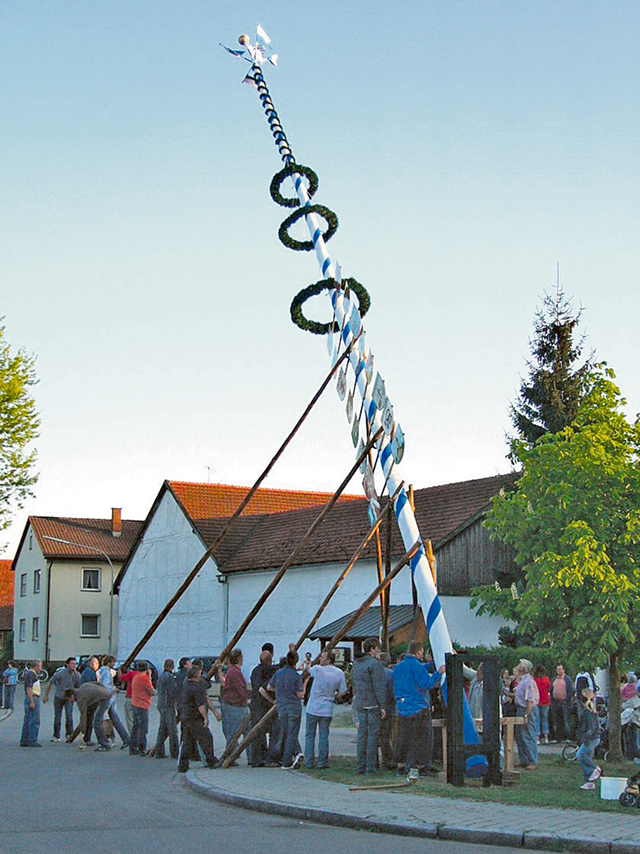
Many communities put up the traditional May tree to celebrate May fests.
May 1 is a special day in Germany and some neighboring countries. Germans observe Labor Day, commemorating May 1, 1890, when it was proclaimed by the first international worker’s congress in Paris as the day of the working class. It was a day to fight for an eight-hour workday and other working-class rights. To this day, trade unions and workers meet for assemblies, demonstrations and political speeches.
It is also the day to welcome spring by observing several traditions. The night prior to May 1, known as witches night, is a night to chase away the demons of winter. It’s also custom-ary for children and teenagers to play tricks on neighbors like ringing doorbells and running off, or putting mustard on door handles.
Residents living off base must keep a watchful eye on their houses and vehicles Thursday night. They should park their cars in the garage, if they have one because if they leave their car outside, they might find it wrapped up in toilet paper or decorated with ketchup the next morning. Residents should also bring outdoor appliances inside for the night, such as doormats and flowerpots (or anything which can be easily picked up); they may be gone or placed somewhere else the next morning.
Sometimes older children or adults do destructive things like lifting drainage covers in the middle of the road or moving traffic signs. Therefore, drivers are asked to be cautious at night and the following morning because these actions can create safety hazards and result in property damage. German Polizei patrol the neighborhoods and will take appropriate action if necessary.
Legend says that on the night of April 30, evil ghosts represented by cold weather, snow and darkness meet with witches and demons at Blocksberg hill in the Harz mountains where they get into mischief before they take off on broomsticks, pitchforks and billy goats at midnight.
The origin of witches night goes back to Pagan times when people believed that evil ghosts tried to prevent the “Queen of Spring” from entering the country. Witches and demons were masters of people and things, so people had to do a lot to protect themselves.
Men made loud noises with whips and gun shots, and lit fires to scare away the demons. Cattle were driven through the fire to secure its fertility for the following year and young couples jumped over the fire to make sure their love would last forever.
Witches night, also called “Walpurgis” night, comes from the English saint Walpurga, who worked as a missionary in Germany in the eighth century and was known for exorcizing demons from the bodies of the sick. In 761, she became the abbess of a monastery in Heidenheim, which was founded by her two brothers Willibald and Wunibald, who were also saints. Walpurga died in 779 and on May 1, 871, her body was transported to Eichstätt to be reburied next to her brothers.
“Dance into May,” or Tanz in den Mai, is another German tradition on May 1. Various associations and sports clubs sponsor this tradition with live music in community halls, sports gyms, gasthauses and other facilities with dancing halls.
In several villages around the KMC, the May tree will be put up on the evening of April 30 or on the morning of May 1. Sometimes this ceremony is combined with a village fest.
The May tree is usually a fir stripped of its lower branches and only the treetop is left untouched. The pole is decorated with colorful ribbons and craftsmen’s trade ornaments such as sausages for the butchers, pretzels for the bakers, or carved wooden figures. May poles symbolize the beginning of spring and hope for a good harvest.
Thursday, May trees will be put up at 7 p.m. on Rathausplatz in Schallodenbach, 6 p.m. on Drehenthalerhof (part of Otterberg), and 5:30 p.m. in Steinwenden.
May 1, May fests will be celebrated at the fire stations in Niederkirchen, Hauptstuhl and in Hirschhorn. In Elschbach’s community hall (Am Weiher 2), a dance into May will begin 7 p.m. on Thursday.







